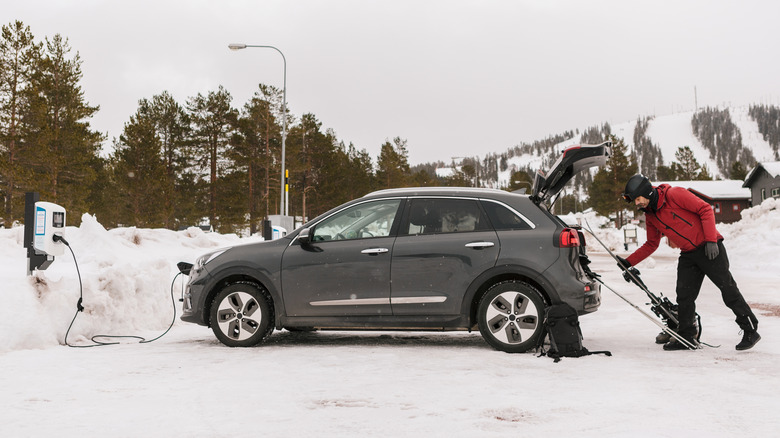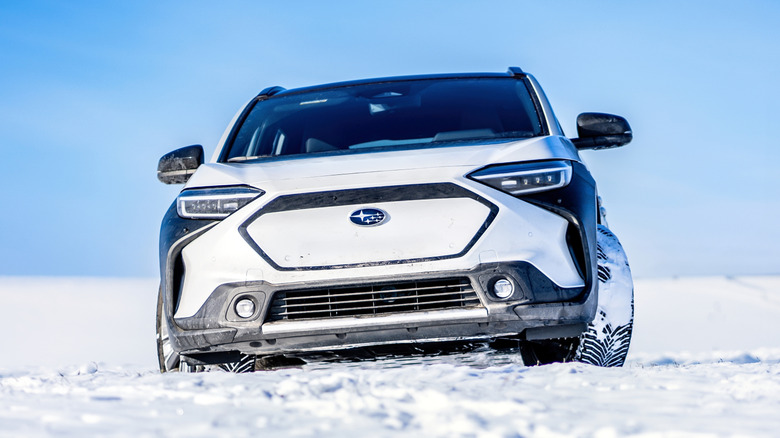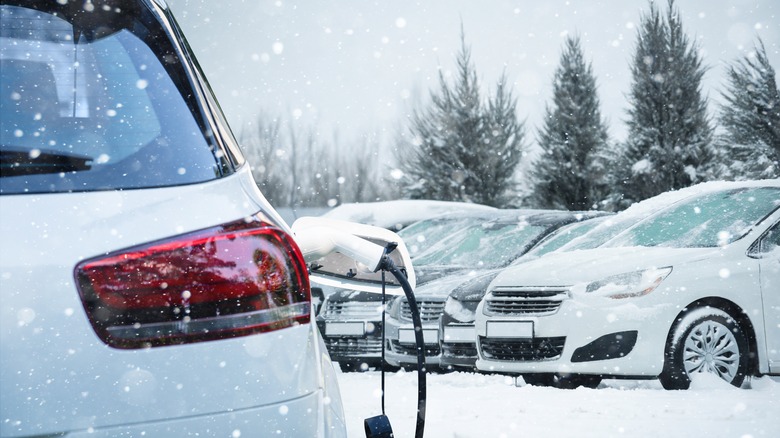Why Might An Electric Vehicle's Range Drop In Cold Weather?
Electric cars offer a long list of benefits compared to gas guzzlers, with long-term cost savings being one of them. Winters and electric vehicles, however, don't always go hand in hand. One of the biggest challenges is the dip in range and charging woes compared to a gas-powered ride. The situation is serious enough that carmakers offer detailed tips on how to get the best out of electric vehicles in cold weather. Tests show the Tesla Model Y's range dropping from 327 (EPA estimate) to just 186 miles in cold weather.
According to testing done by Consumer Reports, the electric range starts to fall when the temperature levels drop to 40 degrees Fahrenheit, and cars can lose up to 25% of their natural range. And if it's a short trip with multiple stops, the loss in range can be as severe as 50% of the advertised numbers. Another challenge is the charging. If the temperatures fall below the freezing point, a standard home outlet won't be able to provide enough energy to charge the battery pack.
That leads to numerous problems, such as long lines at charging stations and a slower charging pace. The best way forward is pre-conditioning. Owners are advised to set a schedule so that the EV can keep its cabin and battery ready. Moreover, they are also told to keep the car plugged in at home so that the battery can stay warm. The idea is to use external power for all the accessory functions, while leaving the battery to focus fully on the core driving part.
The science behind the lost range
There are multiple reasons why the battery pack inside EVs delivers lower mileage than usual in colder temperatures. "In cold weather, vehicles use more energy to overcome increased aerodynamic drag and to heat the cabin and high-voltage battery," explains Tesla. According to the experts at Lectron, cabin heating is the primary culprit behind the lost range. Increased rolling resistance and less effective regenerative braking further contribute to the problem.
The biggest charging and efficiency woes, however, are associated with the slower chemical reactions happening inside the battery. An electric car's battery pack is essentially a chamber for electrochemical reactions. When the temperatures drop, these reactions slow down. When charging happens, lithium ions travel from one electrode to another, through a liquid electrolyte, and produce a current.
When the surroundings get cold, the liquid medium for transporting lithium ions thickens, reducing their movement. Moreover, it leads to lithium plating on one of the electrodes and brings down the ion conductivity, explains a research paper published in the Energy journal.
As a result, the car will take longer to charge, store less energy, and discharge the stored electrical energy at a faster rate. The latter is due to the increased load for internal heating. According to research conducted by the American Automobile Association, the HVAC needs of an electric car driven at 20 degrees Fahrenheit can reduce the combined driving range by a hefty 40%.
Solutions are here, technically
As the shortcomings of electric cars in winter have become more evident, researchers across the globe have proposed various solutions to combat the temperature-related battery efficiency issues. Earlier this year, engineers at the University of Michigan proposed a change in the manufacturing process, which entailed making modifications such as applying a coat of a glassy material made of lithium borate-carbonate that enhances the charging speed even in colder temperatures.
"The team's test cells were 500% faster to charge in subfreezing temperatures," the experts shared in a press release. Research published in the Journal of Energy Storage pushes the idea of a built-in temperature control system that involves increasing the number of fluid channels to improve the temperature distribution across the battery pack. "By increasing the temperature of the fluid from 313.15 K to 333.15 K at a constant flow, the batteries can reach the ideal temperature up to twice as fast," says the paper.
Some of the solutions proposed by scientists actually seem easily achievable, since the mechanisms are already used in mainstream cars, but in a different capacity. Take, for example, regenerative braking. A paper published in the World Electric Vehicle Journal, which analyzed data from over 100 trips made by BMW and Tesla electric cars, suggests that energy harvested from regenerative braking can be used to heat the battery when the external temperatures fall, and can recoup some of the lost range. It's not clear, however, when any of the aforementioned solutions will be implemented on a commercial scale, but the proposals are definitely encouraging.


